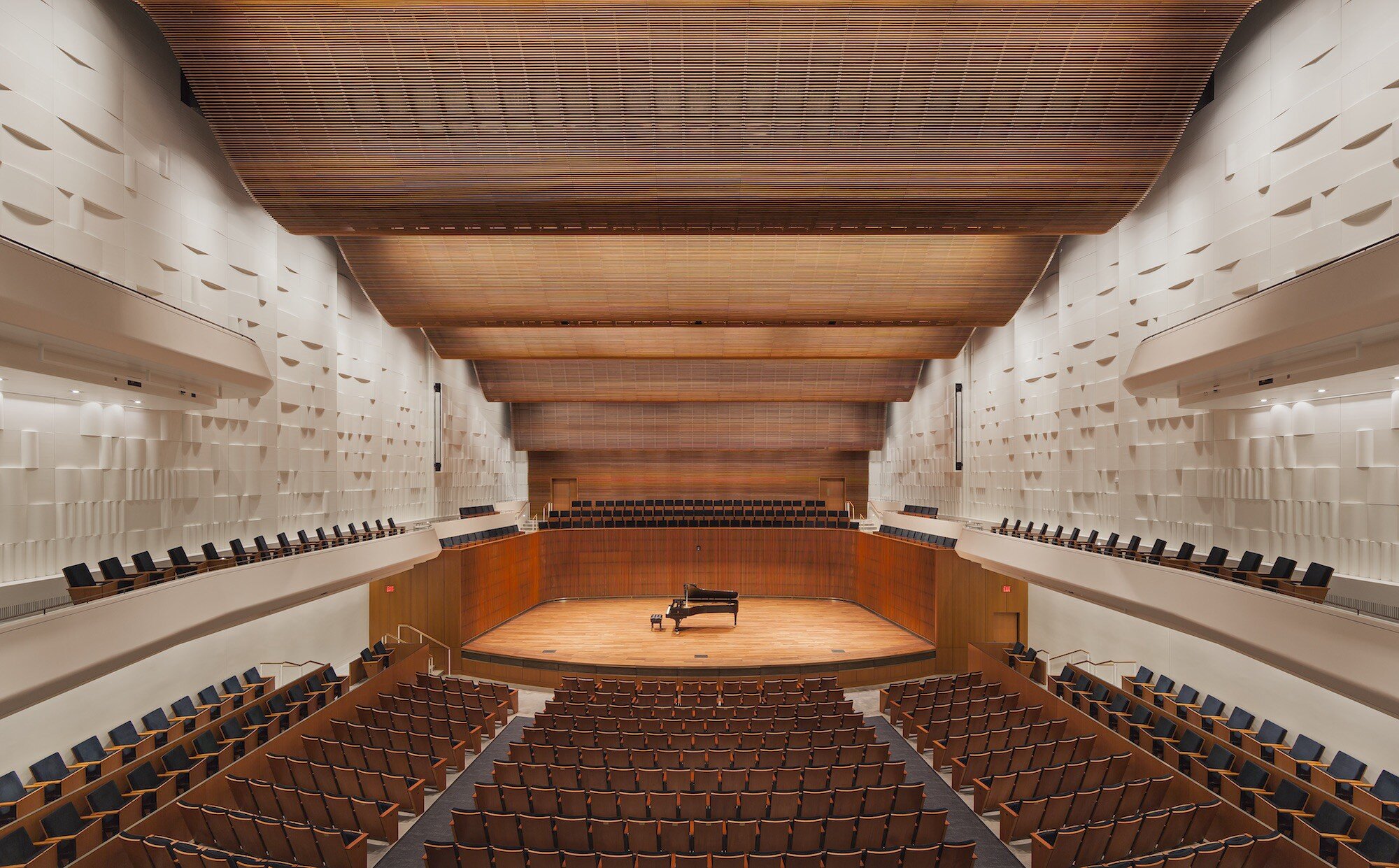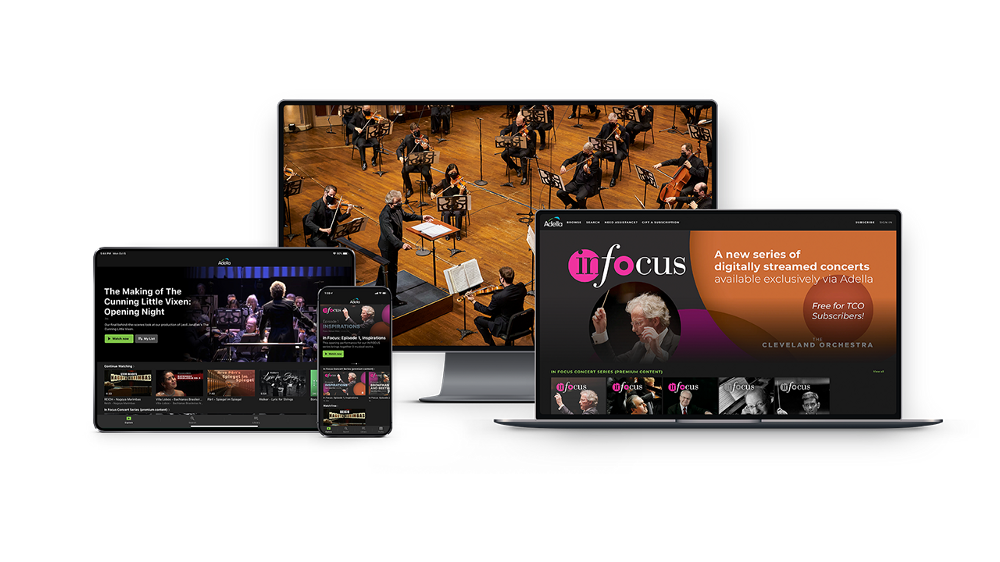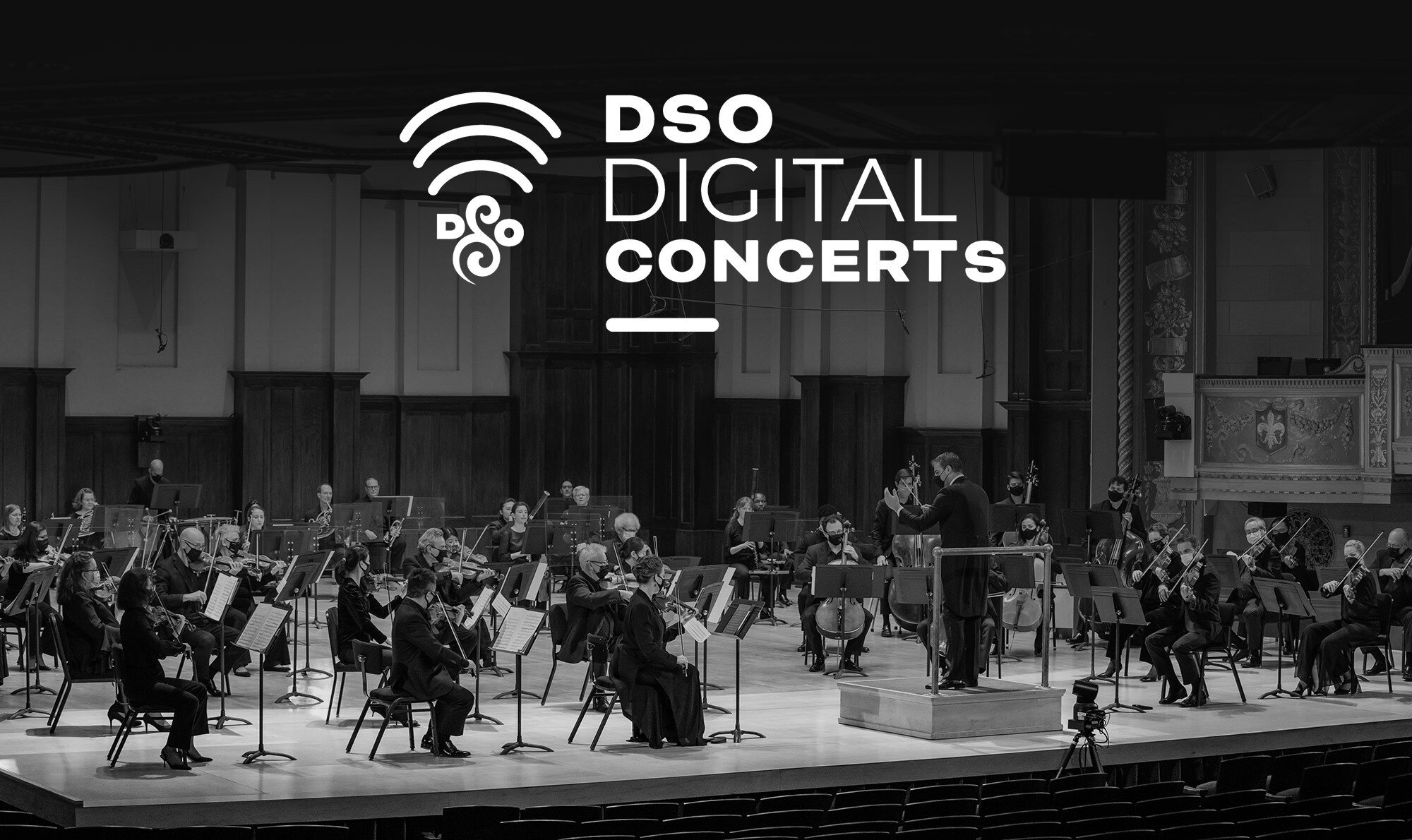Written by Cameron Massey
Cover image: An empty Ordway Center for the Performing Arts in St. Paul, Minnesota. Source: Architect Magazine.
Introduction
When Covid-19 struck stages across the United States in March 2020, orchestras were forced into completely rethinking the ways in which they could stay connected with their communities without filling up their concert halls. In an instant, all classical music producing organizations also became media organizations, or else ran the risk of completely losing touch with their audiences. Stages were traded for live streams and raucous applauses for gradual fadeouts. While countless patterns of ordinary life shuttered to a halt, necessity nurtured a digital concert boom. In an industry saturated in tradition that is often slow to adopt change, long overdue innovations continue to be accelerated at never-before-seen rates. This discovery of a “second stage” presents a potential silver lining in a year that felt devoid of upsides.
While live streaming and on-demand offerings are not completely new to the orchestra world, the pandemic provided a not-so-gentle push to those who treated digital media as an afterthought to the sacred pillar of live performance. Pre-pandemic streaming giants in the classical world included the Berlin Philharmonic’s Digital Concert Hall, the Detroit Symphony Orchestra’s Replay live series, and the Metropolitan Opera’s on-demand catalog. Until now, other orchestral leaders have lacked the incentive to follow suit. But, in the face of do or die, ensembles across the world are increasingly moving away from the polarized thinking that made concert streams a non-starter in the past.
However, as audiences gradually begin filling halls once again, orchestras are having to ask the question of what’s next for this newfound space. Do they take the risk of funneling resources towards streams on the heels of a devastating fiscal year, or divest and potentially sacrifice a newfound means of reaching their communities through increased accessibility?
A Digital Audience is Born
A major barrier to making the leap into streaming was the assumption that audiences would not follow. Yet, in the absence of in person offerings, audiences across the globe flocked in droves to fill their quiet homes with classical music. The classical streaming service Primephonic saw streams in the U.S. jump 20% in the first weeks of social distancing measures. A survey conducted by Baker Richards of over 130,000 regular arts attenders in the U.K. found that engagement with digital cultural offerings jumped from 25% to 59% post-lockdown. Eighty-two percent of those same respondents said they would possibly or definitely consider engaging with digital in the future.
Digital streaming is opening up whole new realms of possibility for revenue production and global reach that orchestras can no longer ignore. The Chicago Symphony Orchestra’s CSO Sessions garnered audiences in 27 countries and 52 U.S. states and territories. Orchestra audiences are ready; it’s just a matter of discovering the right tune.
In an interview with the Chicago Tribune, Chicago Federation of Musicians President Terryl Jares stated:
Some people say, "We don’t ever want to stream, because it will take our live audience away." I don’t ever foresee that ever happening. With streaming, arts organizations can not only sell out a house, but they could watch on-demand and buy a ticket for a discounted rate. It’s just another revenue stream.
A New Medium
Though many initial approaches treated the second stage as a placeholder until the eventual triumphant return to live performance, many orchestras are discovering a new medium for storytelling and meaning making. Instead of treating streams as a replacement for the live music experience, digital media presents greater potential for engaging with communities. People who once felt too intimidated by the concert hall experience (which often includes quietly sitting still for hours on end and choking down coughs while worrying about clapping at the right time) are now open to discovering classical music from the safety and comfort of a familiar living room couch.
Figure 1: Video engineer Brandon Cardley at the Boston Symphony working on creating digital content. Source: New York Times.
Apart from making the concert experience more accessible, going digital also offers the space to innovate and experiment with storytelling. The question of how to produce a concert for the screen is welcoming a sense of adventure in both programming and cinematography. While many orchestras simply reproduced the traditional concert experience in digital form, following the same patterns and tropes of typical programs, some have fashioned offerings more suited to the online medium. The use of media and technology offers the means to expand, deepen, and add texture to the orchestral experience. When asked what’s next for orchestras, Ed Yim, former president of the American Composer’s Orchestra and recently appointed chief content officer of WQXR (New York’s Classical Music Radio Station), urged orchestras to ask more of the digital space:
This past year has been very “by the seat of our pants,” and orchestras that had already fully entered this space—like the Detroit Symphony Orchestra—were able to take content to the next level; they had already figured out how to do it, so they were able to focus strategically on what they were going to put out. Orchestras must reassess why and what they are producing online; the time of online content for the sake of itself is going to end soon.
Streaming Platforms as a Way Forward
Figure 2: Devices showing Adella, the Cleveland Orchestra’s digital streaming app. Source: Cleveland Orchestra.
Though orchestras are still exploring what the future of digital endeavors might look like, many are investing in building out online platforms to house their digital products. In the last year alone, orchestra mammoths like the Chicago Symphony Orchestra, San Francisco Symphony, New York Philharmonic, and Cleveland Orchestra all joined the Detroit Symphony Orchestra with streaming platforms of their own. In a realm of many unknowns, these platforms provide a window into what might be next for streaming and potential signposts for orchestral leaders considering joining their ranks. To explore the future of this second stage, one must simply take a tour of the plethora of digital halls beginning to populate our browsers. The remainder of this post examines the Detroit Symphony Orchestra’s digital concerts (because of their already well-established presence in this space) and two new platforms from orchestras with very distinct artistic voices and missions: the Cleveland Orchestra’s Adella and San Francisco Symphony+. For those shopping for streaming platforms, these three approaches provide the benchmarks against which to evaluate pricing, content, and accessibility.
Detroit Symphony Orchestra Digital Concerts
Figure 3: Promotional image for the Detroit Symphony Orchestra’s Digital Concerts. Source: Detroit Symphony Orchestra.
As the Detroit Symphony Orchestra emerged from a bruising musicians’ strike ten years ago, it set its sights on becoming “the most accessible orchestra on the planet.” The tool to achieve this audacious goal? A newly minted series of free live webcasts presented on its soon-to-be-unveiled streaming platform, DSO Replay. Some of the more traditionalist board members feared a dip in live attendance at Orchestra Hall. Why would audience members attend in person when entire concerts were one touch of a finger away? The opposite happened.
“Pre-strike attendance was about 50 percent of capacity,” CEO Anne Parsons said is a conversation with Musical America in 2015. “Now we have more than 90 percent of the hall sold on a regular basis. I think the digital world makes us hungrier for the real world.”
Way back in 2015, 70% of livestream audience members tuned in from the U.S., 41% of which were local Michigan residents. In a survey sent out to those Michigan-based viewers, audiences who engaged with the streaming platform said the free webcasts made them more likely to attend a concert in person. CRM attendance numbers reflected the survey responses; 66% had attended the DSO in person after engaging online, and 40% attended three or more concerts.
The strike-ending new musician agreement signed in 2011 incorporated “selected media” into the musicians’ salaries. The success of the relationship between the DSO musicians and management in the ten years since bodes well for orchestras negotiating digital distribution rights right now. The DSO is also a trailblazer in how to efficiently record livestreams. Instead of cameramen patrolling the stage during performances, six cameras positioned on the walls around the stage and out in the hall capture all performances remotely. Scenes are wired to the basement control room where directors and score readers call the shots. With all of this in place, the DSO was more prepared than most orchestras when the pandemic hit.
Perusing the DSO’s streaming platform today, visitors can freely replay past seasons going back five years. Audience members can tune in to the 2020-21 season live for $12 per performance or access the entire season with a donation of $125 or more. Along with classroom edition concerts and interviews with musicians and composers, the platform offers on-demand multidisciplinary projects for $9 a piece. A particular highlight, “Poetry + Live Music,” recorded live from The CUBE in Detroit, featured the poet Natasha T. Miller and Chicago-Detroit-based musician, bandleader, and pianist Alexis Lombre, all hosted by spoken word artist La Shaun Phoenix Moore.
Cleveland Orchestra’s Adella
Named after the ensemble’s founder and first general manager, Adella Prentiss Hughes, the Cleveland Orchestra’s new streaming platform Adella launched last October to house the digital 2020-21 season. The ten on-demand “In Focus” concerts can be viewed by orchestra subscribers, donors who contributed over $300 annually, or through a monthly premium subscription for $34.99 a month.
Adella is far less inviting to newcomers than DSO Replay. Those who don’t yet feel ready to field the $34.99 paywall guarding the premium content can only access a handful of excerpts from archival footage, podcast interviews, and a five-minute recording of a minimalist piece for marimba by Steve Reich. While staying true to its mission to “inspire and enrich lives by creating extraordinary musical experiences at the highest level of artistic excellence,” the streaming platform offers little (minimal even) in increasing accessibility.
Figure 4: Video introduction to Adella and In Focus, the Cleveland Orchestra’s streaming platform and on-demand concerts. Source: YouTube.
San Francisco Symphony+
“It would be crazy to come out of this time and go straight back without having learned anything. What we learn in this process is going to stay with us.”
With the release of its first concert created exclusively for the digital space on November 14, 2020, the San Francisco Symphony announced itself as the leader in innovative digital media. “Throughline” set a new standard of what to expect from orchestras in the digital space while reveling the endless potential of this new frontier. It points to the reality that the “old normal” is never coming back and dares the classical industry to embrace the new normal: digital products with farther reach.
The San Francisco Symphony has not slowed down since. By launching its new membership-based streaming platform SF Symphony+ on February 2, 2021, the symphony centralized all of its boundary-defying, forward-thinking content in one place. For $15 a piece, or $120 for full access to the entire 2020-21 roster of performances, subscribers can access SoundBox programs curated by Music Director Esa-Pekka Salonen and the braintrust of Collaborative Partners; explorations of the intersections of classical music traditions with other cultures in the CURRENTS series; and other one-of-a-kind special events.
“It would be crazy to come out of this time and go straight back without having learned anything,” said Esa-Pekka Salonen, music director of the San Francisco Symphony, in a conversation with the New York Times. “What we learn in this process is going to stay with us.”
Don’t feel like paying right now? Not to worry. Hours of high-quality content, including “Throughline,” are available for free. SF Symphony+ opens a door to newcomers and mainstays alike to listen curiously, expand their perceptions, and challenge their assumptions. The San Francisco Symphony is taking advantage of this platform to experiment, take risks, and create performances that would be impossible in a live setting.
Figure 5: Video of “Throughline,” one of the San Francisco Symphony’s digital productions. Source: YouTube.
Conclusion
A few trends emerge for the curious orchestra leader. In terms of platforms to house digital offerings, the newcomer need not be afraid. All three platforms examined above were powered by Vimeo to great effect. The tougher questions of populating those frames remain. Before joining the streaming arena, organizations must be able to differentiate their digital experiences from live ones; provide high quality products, since it’s difficult to charge for a product with little production value; and leverage these platforms in a mission-aligned manner.
“Our digital platform is not a bridge,” says Chad Smith, CEO of the Los Angeles Philharmonic. “If we’re doing our jobs right, this will become its own element of all our work going forward.”
While this year has left the arts world with countless unknowns, one thing is clear: streaming is no longer a product orchestras can continue to shuffle to the back burner. The Covid-19 pandemic has laid to rest the myth that there is no audience for digital. Now that Pandora’s box has been opened, audiences will now expect more from their orchestras.
+ Resources
“Adella Browse.” Cleveland Orchestra. Accessed April 10, 2021. https://www.adella.live/browse
“Analysis: What will cultural audiences pay for digital content?” Baker Richards. September 17, 2020. https://www.baker-richards.com/insights/touch-to-buy-now-will-cultural-audiences-pay-for-digital-content/
Americans for the Arts. “The Economic Impact of Coronavirus on the Arts and Culture Sector.” Updated February 15, 2021. https://www.americansforthearts.org/by-topic/disaster-preparedness/the-economic-impact-of-coronavirus-on-the-arts-and-culture-sector
“Arts and Cultural Organizations: In It for the Long Haul.” SMU DataArts, TRG Arts. Published 2020. https://culturaldata.org/media/2087/longhaul-arts-2020-covid19.pdf
Barone, Joshua. “The San Francisco Symphony Plunges into a New World.” The New York Times. October 28, 2020. https://www.nytimes.com/2020/10/28/arts/music/san-francisco-symphony-nico-muhly.html
Barone, Joshua. “To the Rescue This Year: The People Who Put Orchestras Online.” The New York Times. December 17, 2020. https://www.nytimes.com/2020/12/17/arts/music/classical-concerts-coronavirus-stream.html
“Benchmarks on the Future of Digital.” Advisory Board for the Arts. April 13, 2021. https://www.advisoryboardarts.com/benchmarks-on-the-future-of-digital
Blain, Terry. “Amid pandemic, classical music finally gets its moment on streaming platforms.” Star Tribune. May 15, 2020. https://www.startribune.com/amid-pandemic-classical-music-finally-gets-its-moment-on-streaming-platforms/570503692/
Cantrill Fenwick, Robin. “What Can – and Should - You Charge Digital Audiences?” ArtsProfessional, September 15, 2020. https://www.artsprofessional.co.uk/magazine/article/what-can-and-should-you-charge-digital-audiences
Clawson, Kerry. “Cleveland Orchestra Launches New App for Fall Series of Streamed Concerts.” Akron Beacon Journal. Updates October 11, 2020. https://www.beaconjournal.com/story/entertainment/arts/2020/10/08/cleveland-orchestra-launches-new-app-streamed-fall-concert-series/3635672001/
Cooper, Michael. “San Francisco Symphony Lands a Disrupter: Esa-Pekka Salonen.” The New York Times. December 5, 2018. https://www.nytimes.com/2018/12/05/arts/music/san-francisco-symphony-esa-pekka-salonen.html
“CSOtv.” Chicago Symphony Orchestra. Accessed April 11, 2021. https://cso.org/csotv-landing
Crittenden, Elizabeth. “Video Streaming Trends For Performing Arts Organizations.” Arts Management and & Technology Lab. January 14, 2021. https://amt-lab.org/blog/2020/12/streaming-trends-performing-arts
“Digital Streaming: Reaching a Larger Audience through Digital Means.” Musical America Worldwide. 2015. http://www.musicalamerica.com/specialreports/STREAMING_2015.pdf
“DSO Replay.” Detroit Symphony Orchestra. Accessed April 10, 2021. https://livefromorchestrahall.vhx.tv/browse
Edgar, Hannah. “Live audiences are (hopefully) coming back. Where does that leave streaming concerts?” Chicago Tribune. April 5, 2021.https://www.chicagotribune.com/entertainment/music/ct-ent-archiving-classical-concert-streams-20210405-hjgvqtyj3zeetkam4m2jmbpvpy-story.html
Garcia-Maunez, Ana. “Orchestras' Post-Pandemic Digital Future.” Arts Management and & Technology Lab. December 3, 2020. https://amt-lab.org/blog/2020/12/orchestras-post-covid-digital-future
Gensler, Eric. CI Eye to Eye with Anastasia Boundanoque, Rock 'n' Roll Numbers—ClassicalMusic Content during the Pandemic. Capacity Interactive. Podcast audio. August 4, 2020. https://ideas.capacityinteractive.com/ci-to-eye-podcast-episodes/rock-n-roll-numbers-classical-music-content-during-the-pandemic-anastasia-boudanoque
Gensler, Eric. CI Eye to Eye with Matias Tarnopolsky, Every Arts Organization Must Become a Media Company. Capacity Interactive. Podcast audio. March 31, 2020. https://ideas.capacityinteractive.com/ci-to-eye-podcast-episodes/every-arts-organization-must-become-a-media-company-mat%C3%ADas-tarnopolsky
Greene, Janaya. “What’s Next for Orchestras?” Symphony, League of American Orchestras. Winter 2021. https://americanorchestras.org/wp-content/uploads/2021/02/Whats-Next-for-Orchestras.pdf
Hooper, Ryan. “The DSO Goes Digital: Online Performances May Become New Norm After COVID-19.” WDET. CultureShift. March 20, 2020. https://wdet.org/posts/2020/03/20/89381-the-dso-goes-digital-online-performances-may-become-new-norm-after-covid-19/
“NYPhil+ Browse.” New York Philharmonic. Accessed April 11, 2021. https://plus.nyphil.org/browse
Philharmonia. “Film, Web & Audio.” Accessed April 9, 2021. https://philharmonia.co.uk/what-we-do/digital-immersive/film-web-and-audio/.
Steinberg, Briel. “How Performing Arts Organizations Are Redefining Audience Engagement During COVID-19.” CCS Fundraising. April 30, 2020. https://ccsfundraising.com/how-performing-arts-organizations-are-redefining-audience-engagement-during-covid-19/.
“SF Symphony Plus Browse.” San Francisco Symphony. Accessed April 10, 2021. https://www.sfsymphonyplus.org/browse
“Throughline: San Francisco Symphony - From Hall to Home.” San Francisco Symphony. November 14, 2020. https://www.sfsymphony.org/Watch-and-listen/Events/Throughline
Wise, Brian. “Sounds from a Distance.” Symphony, League of American Orchestras. Winter 2021. https://americanorchestras.org/wp-content/uploads/2021/02/Sounds-from-a- Distance.pdf
Wassenberg, Anya. “Live Streaming Is Here to Stay - The Future of An Emerging Technology.” Ludwig van Toronto. April 20, 2020. https://www.ludwig-van.com/toronto/2020/04/20/report-live-streaming-is-here-to-stay-the-future-of-an-emerging-technology/
“3 Trends to Watch Out For in Post-Pandemic Digital Media & Entertainment.” Advisory Board for the Arts. Accessed April 9, 2021. https://www.advisoryboardarts.com/3-trends-to-watch-out-for-in-post-pandemic-digital-media-entertainment




